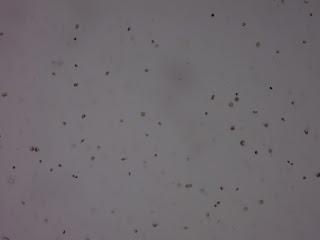Alright, alright well this week was certainly interesting. As of last Friday, our last diatom cultures, the Thalassosira, reached maturity after being exposed to the oil. (I don't think I mentioned it in my last post, but we decided to use our batch of Thalassiosira to compare to the Chaetoceros since they're both diatoms and we had the culture ready to be used.) Looking at these bottles, I can tell the difference between each of the cultures is going to be much more minute.
After measuring and calculating out the cell density, I found the average density of the standard (aka, the control) cultures was 1.73x10^6 cells/mL. The culture that had been exposed to one drop (or 166 ppm of oil) increased in cell density to 4.11x10^6 cells/mL. After what we saw with the Chaetoceros cultures, this increase not alarming in the slightest. What was surprising though was that our culture containing three drops (about 500 ppm) decreased significantly in cell density to 9.77x10^5 cells/mL. This trend wasn't consistent, as the ten drop (1660 ppm) culture showed another increase from the control at 2.44x10^6 cells/mL. Likely, the inconsistency can be contributed to either a foreign contaminate or a lack of proper aeration.
But this off-trend pattern of cell density wasn't the only alarming trait of these cultures. At 1660 ppm, we noticed some of the cells had oblonged themselves and attached to other cells. We also noticed strange "ghost" cells forming in the oil drops. Below is first a picture of a normal cell group within the 1660 ppm culture, and then an example of the stretched cells and the translucent cells at the 40X objective.
A researcher at the Dauphin Lab had some interesting theories about why the cells did this. The translucent cells could be formed from dissolved organic carbon (DOC) produced by the Thalassiosira. "In a culture, DOC congeals through random interactions such that the "sticky" DOC particles aggregate into larger particles collectively called "Transparent Exopolymeric Substances" (aka TEP). TEP is reactive and will cause aggregations, especially with crude oil droplets," according to Mr. Jeffery Krause. He also said that depending on how we aerated the culture, the phytoplankton could have reacted with the oil. He didn't specify how, as he's only been at the lab since 2012 and didn't study the Deepwater spill personally, but he did refer me to a "Gulf of Mexico Initiative (funding agency) research consortium" that solely researches with those types of interactions.
Overall, I'd say this part of the experiment did not reveal anything about my hypothesis, but it did help to deepen my understanding of phytoplankton on a cellular level.
Today, I'll be going back to Mr. Soderblom's to record data on the green phytoplankton we began experimenting with last Friday and have now probably reached maturity.
Signing off till next time, this is Erin Butcher.













